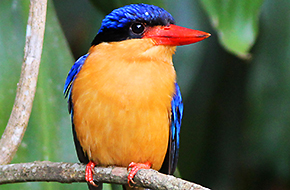A Novel
<Alice Greenway
Grove Press
Jim Kennoway is a boozer. Seventy years old, an experienced, well-respected ornithologist, he suddenly finds himself what he calls "a cripple" (part of one leg has recently been amputated due to infection). So the hero of Bird is (1) old (2) drunk (3) friendless. (4) heavy into self-pity (drunks usually are, unless they are comedians, but this guy is no Jackie Gleason)In other words, we are going to have to put up with this tedious tippler for 300 pages. Not an auspicious weekend's reading project, eh? Usually, unless they are named Under the Volcano, novels about lonely drunks are not very entrancing, because drunks aren't very entrancing. You could spend an evening talking to the regulars at the "The Soiled Budgie Extraction System," "The Pope & Proctologist," "The Festering Carbuncle," "The Occasional Leg," "Sockless in Gaza," "The Scarlet Pimple Knell," or "The Collective Noun Of Tampons" --- sorry, I got carried away there. I went looking online for interesting pub names, and found a list of 324 at http://www.readersdoglist.com. Sorry.
Anyway, most drunks I know, live lives of circular desperation. Get up in pain in the morning. Cure the pain by the "hair of the dog." (Whose dog, what breed . . . never mentioned). Try to be out of it as far as possible when one of the few remaining numbers of your previous buddies or family put in an appearance.
Jim (and the author) live up to all these prerequisites, but the novel is partially redeemed by an interesting twist: by the fact that Jim was a lifelong bird-head. Not those parrots at the booze-hall, but obscure birds of the tropical and sub-tropical Pacific, especially around Hawaii and the New Georgia Islands.
Jim taught himself to be a champion bird skinner, and after you read this, you can be one too. Careful round the eyes. That's where it gets tricky.
In fact the detail work on the many birds that fly through his life and our book is quite enrapturing. So much so that if we can skip over the brooding first martini-at-eleven-AM sequences, and get into the tremendous range of bird-life in Borneo and Jim's expertise, it can be a page-turner.
Remember, it ain't bird-watching. Here, you shoot a bird that interests you, do the skinning and preserving, as cleanly, neatly, and as artistically as possible, recreating the bird as it appeared before you shot it.
Me? I think stuffing a turkey at Thanksgiving is a big sloppy mess: sage, parsley, rosemary, thyme and grease all over the floor. You think that's tough; imagine trying to cut into a Ptilinopus viridis --- the Red-throated fruit dove from the island of Layla,
Head and chin, dark gray green and olive. Wings and tail, olive green with pale gray shoulder patch and gray spots on the tertials. Lower breast and abdomen deeper green. Under tail-coverts yellow. Throat, crimson Iris, orange. Bill, yellow. Feet red. Crop full of fig seets. Gonads enlarged.
Then, "So beautiful you almost regret shooting it."
There's another bird that turns up here. Her name is Cadillac. Jim knew her father when he was on the Solomon Islands. This man --- named, get this, "Tosca" --- remembers Jim with affection (they did birds and stabbed Japanese soldiers together during WWII). When his daughter --- tall, elegant, black Cadillac --- wins a medical scholarship to Yale, she turns up for her introduction to the real America at Penobscot Bay, Maine where Jim lives trying to murder himself with his daily overdose of Beefeaters.
Cadillac knocks everyone off their feet by being from another world, all the while speaking perfect English, showing herself to be wonderfully self-sufficient, being perfectly happy, having a great time there despite this snarly stinky old boozer (we readers get somewhat smitten with her too).
Now if Greenway were your normal boring novelist, Cadillac would rescue Jim from Demon Rum, he would quickly turn contented-though-crippled, she would marry his son Fergus, and they'd live happily after, shooting Blue-footed Boobies and Least Grebes and stuffing them while Cadillac goes on to be a top-drawer brain surgeon.
Well spare us that, and usually, I wouldn't think it fair if I reveal for you, a potential reader, the conclusion to Bird. But I am going to ignore that unwritten law, because, even though it is more interesting that the plot I have outlined above, the novel is still a cop-out. Worse, it demonstrates all too well something about those who think they can write about the disabled without doing their homework.
Greenway has done a mountain of research on bird-skinning and bird-skinners (and birds), but her study of those with a stump where the leg should be is so pitiful that she should be drummed out of PEN by the elders of the Prosthesis Club of America. At the very least, she could have spent a few weeks boning up on the best of disability writing, learning the reality of disability by those who were there: Hugh Gallagher, John Callahan, Robert Murphy, Barry Corbet, Christopher Reeve (and, by proxy, Susan Parker). Then she wouldn't have forced us to wade through her dreadfully awkward write-up of "the disability experience."
For example, Jim, the author tells us, has morning sickness:
It's the same each morning. He has to get used to it all over again. Grapple with his own self-pity and disgust. His fingers recoil as they reach around the smooth stretched skin, the hard ridges of scar.
It's too easy, and the picture of Jim and his hurt (physical, social, psychic) has all the depth of a pancake. One left over from last week.
Yes, at times we go boozy or become full-time pill-heads, but Jim has too much brain-power and experience to go solely this route: he lived through the worst part of the Pacific island wars between 1941 - 1945; he has seen too much to believe that he's "a hopeless cripple."
My guess is that he would more probably do what the rest of us do: put up with it, swing (at times) from bleak black utter washout despair to unreasoning hope . . . during, say, a spectacular dawn over Fox Island, a fledgling Caracarasan or a Polioptila caerulea gnatcatcher stopping over on its way to Boston.
But Greenway doesn't give Jim a chance, murders him ahead of time with simplistic (and very bad) psychology. Which loads the dice and cheats the reader.
I am put in mind of those plays and novels and stories of the 50s, where the hero is a respectable pillar of the community and, gasp, gay. (They didn't call it gay back then: mostly "invert" or "homosexual" or --- in some circles --- "a poof.") They find this up-and-coming young man in bed with the butler or the houseboy or some seedy stranger. So what does he do? Hanging was usually easiest. Less messy. More dramatic: that bleak dangling shadow on the far wall.
The message was quite simple. You're queer. You're discovered. You're better off dead.
And Jim? He's on his last leg, right? We'll fix him up, says the author. A one-barrel shotgun from England. Let's put him out of his misery with class:
The gun is heavy and solid. There's purpose in the loading, in the firm catch of the well-oiled breech.
There in the boathouse, the doors flung open so Jim and the reader can have a glorious view of Penobscot Bay as he is doing the dirty deed. A seventy-year-old one-time champion scientist . . . now a hopeless cripple.
There's no other out, right, for the author, the reader, the characters. Let's be done with it and him and this body that's turned him so completely useless.
BANG!

